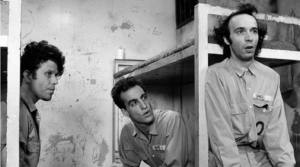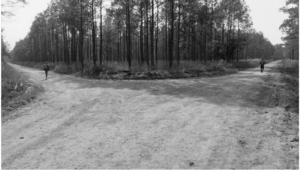Down By Law (1986): Jim Jarmusch’s Tribute to the Drifter
Landen Fulton

Tom Waits, John Lurie, and Roberto Benigni in Down By Law — Island Pictures
Known for its minimalism, offbeat comedy, and melancholic nature, Jim Jarmusch’s filmography eclipses convention to create a new approach to independent cinema — the embodiment of the post-modern. Jarmusch first emerged from New York’s indie film scene with his 1980 debut Permanent Vacation but didn’t establish his name, or eccentric reputation, until the release of his sophomore feature Stranger than Paradise (1984), which was awarded the Palme d’Or at the Cannes Film Festival that year. Upon receiving both critical and commercial acclaim, Jarmusch became a staple among contemporary American filmmakers and continued to develop his individual aesthetic through his third feature film, Down By Law (1986). In his early works, Jarmusch repeatedly concentrates on multiculturalism, coincidence, punk culture, and, most commonly, the perspective of the outsider. Jarmusch has often referred to himself as an estranged American, a conceit only further embodied through his characters. They encapsulate the attitude of the drifter — those living on the margins of establishment, faced with incommunicable loneliness and ideological exile from their modern, mainstream American homes. By exploring this displacement within Down By Law, Jarmusch combines his distinct stylization with the hallmarks of classical film movements to create his opus tribute to the isolated and estranged.
All roads lead to nowhere — Down By Law follows three idiosyncratic characters guided by dissatisfaction and fate as they navigate the heat-induced delirium of the New Orleans’ streets. Zack (Tom Waits), an unemployed disc jockey known as Lee “Baby” Sims, lets his poised radio persona fade into the airwaves as, in reality, his restless exterior is a bohemian vagrant solely concerned with his next bottle and the polish of his pointed, black-leather oxfords. As Jack, John Lurie plays a post-punk-inspired pimp defined by an effortless cool; he dreams of music, women, and white limousines. Acting as the personification of Louisiana’s smooth jazz, his suave indifference divides him from his counterparts as a man capable of blurring high class and low culture. After a series of false incriminations, the two characters’ paths cross behind bars. As cellmates within the confines of Orleans Parish Prison, their impenetrable dispositions form an ever-present tension pierced only by the addition of Roberto (Roberto Benigni). The Italian tourist, who is obsessed with American idioms, finds himself in jail for the accidental killing of a man he played against in a dishonest game of cards. Roberto, and his quick-witted, broken English, serve as a jaunty catalyst for the men’s jail time. He disturbs their monotonous routines by introducing a plan to escape, but, once outside, the three men are forced to navigate the murky swamps of the surrounding Louisiana bayou to establish a life beyond their former identities.
The film opens with Tom Waits’ “Jockey Full of Bourbon” acting as gritty melodic commentary that parallels the footage of a disheveled southern hellscape — Creole-style architecture contrasted by pile dwellings, a hearse parked outside tall cement mausoleums, and the poverty-ridden swamps cut against the diversity of the city’s French Quarter. Jarmusch’s inclusion of this introductory montage captures a documentary-like essence of New Orleans and serves as the audience’s first glimpse at his stylistic influence — the Italian Neo-Realist Movement. Italian Neorealism emerged out of post-World War Europe to mark the shift from highly theatrical productions to an emphasis on life in the real world. Through documentary-style camera work, the use of non-professional actors, and the significance of contemporary struggles, the movement forgoes the popularity of conventional fiction to draw attention to the harshness of reality. The rejection of traditional imitative cinema follows Jarmusch’s intended withdrawal from formulaic Hollywood cinema. Waits, a musician; Lurie, a painter; and Benigni, a comedian, are actors only by proxy. By exemplifying Neorealist attributes, Jarmusch’s decision to cast the three protagonists stemmed from their personalities that parallel their characters rather than their experience or professional backgrounds.
Immediately following the montage, their dual introductions establish Zack and Jack’s similarities. Zack’s partner yells, breaking his records and destroying his already-dingy French colonial apartment as he sits on his frameless bed watching. He never interrupts her enraged monologue and remains composed, seemingly indifferent to the world beyond himself. As she tries to provoke him, he only leaves, strolling into the city streets now littered with his belongings. With the smooth melody of a trumpet playing behind him, he laces up and polishes his leather shoes as he sits on the curb with the same constant expressionless stare. The film subsequently cuts to Jack, sitting next to his escort, as she lectures him on money and behavior and demeaningly scorns his profession. Similarly, he sits in silence, fully attentive but unaffected and indifferent to her words. Zack and Jack’s lack of reaction to these attempts at humiliation establishes the pair’s exhaustion with the repetition of their reality. To the strum of their own beat, they both live independently, without conform. Their cool-headed attitudes front the boredom of their patterns of failed relationships and illegal entanglements. Even so, they see themselves outside the bounds of convention, and only continue their uncaring transgressions. As Zack is set up and caught for transporting a body and Jack unknowingly attempts to hire an underage girl, the two find themselves arrested and only further separated from society.

Zach (Tom Waits) in Down By Law — Island Pictures
Jarmusch writes these characters as intentionally morally gray. This cynical protagonist trope, paired with the creative direction to film the movie in black and white, expresses the clear influence of Film Noir. A genre prominent in post-World War II American crime dramas, these films often follow ethically ambiguous individuals and the existential themes that accompany their discontent lives. The movement foregrounds the hollowness of small-town existence and the American dream, analogous to the apprehensive narrative in Down By Law. To prioritize this obscurity, Jarmusch disavows detail-oriented writing. The film doesn’t show the men’s trials. Just as the protagonists, the audience is thrown in a jail cell where only Zack, Jack, and the occasional guard are seen. The second act includes few plot points, scantily limited to cell bars, scribbled-on gray walls, and the few begrudging interactions between Jack and Zack. Despite their clearly similar personalities, their incompatibility further plays on their unwillingness toward acceptance. Just as their lives outside the prison, their days merge into a single stream of restlessness. Zack starts to record their time with scratches on the walls, but the duration of their sentence is never explicitly revealed. The story only begins to progress after the third key figure, Roberto, joins the cell. At first, Zack and Jack treat him with the same stone-faced distance, but the dynamic is soon broken by Roberto’s comedic relief. Despite the initial tension, the three men form a hesitant bond over cards, ice cream, and the absence of a cigarette lighter.
Despite Jarmusch’s continued emphasis on the repetitiveness of their lives in prison, he abruptly shifts the narrative through a seemingly insignificant conversation where Roberto subtly introduces an escape plan. The frame shows the guards escorting the men out of the cell for their daily walk and then suddenly jumps to black. A complete change in locale is displayed as the men run through a dark tunnel away from the prison. In the span of just one minute onscreen, Jarmusch abandons the prison setting — the unvarying existence he’d established for his characters — and again throws them into the dense muck of life outside. Roberto’s get-away plan is never explained, and how the men escape is never shown. Instead, Jarmusch focuses on the before, during, and after of their prison time. The lack of detail is not a shortfall or underdevelopment of the plot but an intentional omission. He focuses on how the circumstances shift the characters’ dynamic rather than the circumstances themselves. Such decisions are what distinguishes Jarmusch’s filmmaking from the conventional Hollywood formula. In Down By Law, chance and ambiguity play a key role in the storyline. This opposes the elaborate, plot-oriented cinema that dominates contemporary film narrative. To Jarmusch, Hollywood’s need for constant explanation is futile. Down By Law recognizes life itself has no plot, and Jarmusch writes the film as an imitation of this idea.
Hurled into the wilderness by fate, directionless, the men continue to wander as they traverse the homogeneous, muddy landscape in the same cadence. Despite their original aversions, they agree to help each other until they’re able to reunite with civilization. Regardless of whether their partnership derives from fear or actual coalition, this is the first time the men willingly partake in some form of community. Their bond may be unspoken and ambivalent, but its clear presence is a significant shift in the third act. Even with their persistent attempts to maintain apathy, subtle beams of redeeming light seep through the bayou’s murky waters; after Roberto exclaims his inability to swim, his two counterparts seemingly leave at first, but Zack returns to rescue him from the prison dogs. As Zack and Jack continue their power struggle and vow to split up, their solo hysteria only leads them back to one another. The newfound reluctant camaraderie is not only an evolution in the characters’ relationships but provides solace for the drifters in the form of unprecedented resonance.
Upon finally reconvening with the society the men had originally so diligently sought to reject, each character aims to reinvent themselves. They stumble upon a local diner owned by Nicoletta, another Italian immigrant, discovering they now sit on the border of Louisiana and Texas. This implies that men crossed over 200 miles of terrain from their prison in New Orleans to the location of their final on-screen destination. Over the course of a single night at the diner, Roberto falls in love and promises to stay with Nicoletta. Their whirlwind romance is only another characteristic that adds to the screenplay’s absurdity. But while Roberto’s decision to stay ties him to the backwaters, Zack and Jack’s conclusions aren’t as direct. The two continue to match each other’s sarcastic digs until the film’s final scene, where they find themselves at a literal crossroads. Jack plans to go west, Zack plans to go east — neither one of them knows which direction is which. In a final taunting gesture, the two men trade jackets. It’s a subtle exchange that once again shows their parallels. As their names suggest, and despite their marriages to their sovereignty, Jack and Zack are interchangeable. They think they’re misunderstood and totally unique, but their need for individuality only prevents them from seeing their likeness. The brief partnership is ultimately eclipsed by the returning desire for solitude, obstructing any potential to establish a lasting community and further ingraining them into the disconnect they appear to crave.
There is no resolution. The audience doesn’t know where the men are going or what they’ll do, and neither do they. The characters have no plan or path, but they haven’t their entire lives. Characteristically, Jarmusch leaves the final scene ambiguous. Jack and Zack walk in opposing directions, at the cusp of their new lives and identities. As they once again both walk aimlessly alone and point to each other in a final sign of sardonic respect, the audience is left to wonder — did they change? Did their temporary brotherhood pierce their needed independence or do they revert back to the same patterns of isolation? After all, until their prison stay, isolation was all they knew. Perhaps the experience spurred their aspirations for a life without the same hollow repetitions; maybe they find their respective communities, or maybe they’ll never be able to again. The lack of conclusion is Jarmusch’s final ode to both the characters and the film’s intended audience — fellow drifters, estranged Americans, and those without purpose, destination, or accord.

Down By Law‘s Final Goodbye — Island Pictures

